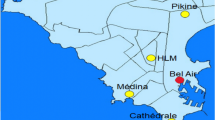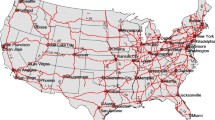Abstract
In the mid nineteen eighties the Dutch NOx air quality monitoring network was reduced from 73 to 32 rural and city background stations, leading to higher spatial uncertainties. In this study, several other sources of information are being used to help reduce uncertainties in parameter estimation and spatial mapping. For parameter estimation, we used Bayesian inference. For mapping, we used kriging with external drift (KED) including secondary information from a dispersion model. The methods were applied to atmospheric NOx concentrations on rural and urban scales. We compared Bayesian estimation with restricted maximum likelihood estimation and KED with universal kriging. As a reference we also included ordinary least squares (OLS). Comparison of several parameter estimation and spatial interpolation methods was done by cross-validation. Bayesian analysis resulted in an error reduction of 10 to 20% as compared to restricted maximum likelihood, whereas KED resulted in an error reduction of 50% as compared to universal kriging. Where observations were sparse, the predictions were substantially improved by inclusion of the dispersion model output and by using available prior information. No major improvement was observed as compared to OLS, the cause presumably being that much good information is contained in the dispersion model output, so that no additional spatial residual random field is required to explain the data. In all, we conclude that reduction in the monitoring network could be compensated by modern geostatistical methods, and that a traditional simple statistical model is of an almost equal quality.
Similar content being viewed by others
References
Berger JO, De Oliveira V and Sanso B (2001). Objective bayesian analysis of spatially correlated data. J Am Stat Assoc 96: 361–1374
Bertino L, Wackernagel H (2002) Case studies of change-of-support problems. technical report N–21/02/G, ENSMP—ARMINES, Centre de Géostatistique, Fontainebleau, France
Bourennane H, King D and Couturier A (2000). Comparison of kriging with external drift and simple linear regression for predicting soil horizon thickness with different sample densities. Geoderma 97(3–4): 255–271
Bourennanne H, King D, Chery P and Bruand A (1996). Improving the kriging of a soil variable using slope gradient as external drift. Eur J Soil Sci 47(4): 473–483
Box GEP and Cox DR (1964). An analysis of transformations. J Royal Stat Soc B 26: 211–246
Cassiraga EF, Gomez-Hernandez JJ, Soares A, Froidevaux R (1997). Improved rainfall estimation by integration of radar data: a geostatistical approach. Proceedings GeoENV I—Geostatistics for environmental applications. Lisbon, Portugal, 18–19 November 1996. Kluwer Academic Publishers, Dordrecht, The Netherlands. pp 363–374
Chilès JP and Delfiner P (1999). Geostatistics: modeling spatial uncertainty. Wiley, New York
Cui H, Stein A and Meyers DE (1995). Extension of spatial information, Bayesian kriging and updating of prior variogram parameters. Environmetrics 4: 373–384
Derwent RG, Hov O, Asman WAH, Van Jaarsveld JA and De Leeuw FAAM (1989). An intercomparison of long-term atmospheric transport models; the budgets of acidifying species for the Netherlands. Atm Environ 23: 1893–1909
Desbarats AJ, Logan CE, Hinton MJ and Sharpe DR (2002). On the kriging of water table elevations using collateral information from a digital elevation model. J Hydrol 255(1–4): 25–38
De Oliveira V, Kedem B and Short DA (1997). Bayesian prediction of transformed gaussian random fields. J Am Stat Assoc 92: 1422–1433
Diggle PJ and Ribeiro Jr. PJ (2002). Bayesian inference in gaussian model-based geostatistics. Geograph Environ Model 6(2): 129–146
Diggle PJ, Tawn JA and Moyeed RA (1998). Model-based geostatistics (with discussion). Appl Stat 47: 299–350
EPA (1998). National air quality and emissions trends. Report 1997, U.S. environmental protection agency, Triangle Park N.C., America
Gelman A, Carlin JB, Stern HS and Rubin DB (2003). Bayesian data analysis, 2nd edn. Chapman & Hall, New York
Genikhovich E, Filatova E and Ziv A (2002). A method for mapping the air pollution in cities with the combined use of measured and calculated concentrations. Int J Environ Poll 18(1): 56–63
Goovaerts P (1999). Using elevation to aid the geostatistical mapping of rainfall erosivity. Catena 34(3–4): 227–242
Goovaerts P (2000). Geostatistical approaches for incorporating elevation into the spatial interpolation of rainfall. J Hydrol 228(1–2): 113–129
Grimes DIF, Pardo-Igúzquiza E and Bonifacio R (1999). Optimal areal rainfall estimation using raingauges and satellite data. J Hydrol 222(1–4): 93–108
Handcock MS and Stein ML (1993). A bayesian analysis of kriging. Technometrics 35(4): 403–410
Hengl T, Heuvelink GBM and Stein A (2004). A generic framework for spatial prediction of soil variables based on regression-kriging. Geoderma 120: 75–93
Hudson G and Wackernagel H (1994). Mapping temperature using kriging with external drift: theory and an example from Scotland. Int J Climatol 14(1): 77–91
Jazwinski AH (1970). Stochastic processes and filtering theory. Mathematics in Science and Engineering, Vol 64. Academic Press, New York
Kitanidis PK and Shen KF (1996). Geostatistical estimation of chemical concentration. Advances in Water Resources 19(6): 369–378
Lajaunie C, Wackernagel H (2000) Geostatistical approaches to change of support problems, theoretical framework. technical report N–30/01/G, ENSMP—ARMINES, Centre de Géostatistique, Fontainebleau, France
Lehmann EL (1975). Nonparametrics: statistical methods based on ranks. Holden-Day, San Francisco
Meinhold RJ and Singpurwalla ND (1983). Understanding the kalman filter. The Am Stat 37(2): 123–127
Monestiez P, Courault D, Allard D and Ruget F (2001). Spatial interpolation of air temperature using environmental context: Application to a crop model. Environ Ecolo Stat 8(4): 297–309
Pardo-Igúzquiza E (1998). Comparison of geostatistical methods for estimating the areal average climatological rainfall mean using data on precipitation and topography. Int J Climatol 18(9): 1031–1047
Pauly M and Drueke M (1996). Mesoscale spatial modelling of ozone immissions. An application of geostatistical methods using a digital elevation model. Gefahrstoffe reinhaltung der luft 56(6): 225–230
Ribeiro Jr. PJ and Diggle PJ (1999). Bayesian inference in Gaussian model-based geostatistics. Technical report ST-99-08, Department of Mathematics and Statistics, Lancaster University, Lancaster, United Kingdom
Stein A, Van Eijnsbergen AC and Barendregt LG (1991). Cokriging nonstationary data. Mathe Geol 23(5): 703–719
Van de Kassteele J and Stein A (2006). A model for external drift kriging with uncertain covariates applied to air quality measurements and dispersion model output. Environmetics 17(4): 309–322
Van Elzakker BG (2001) Monitoring activities in the Dutch national air quality monitoring network in 2000 and 2001. RIVM report 723101055, National Institute of Public Health and the Environment, Bilthoven, The Netherlands
Van Jaarsveld JA and De Leeuw FAAM (1993). OPS: An operational atmospheric transport model for priority substances. Enviro Software 8: 93–100
Van Jaarsveld JA (1991) An Operational atmospheric transport model for Priority Substances; specification and instructions for use. RIVM report 222501002, National Institute of Public Health and the Environment, Bilthoven, Netherlands
Van Jaarsveld JA (1995) Modelling the long-term atmospheric behaviour of pollutants on various spatial scales. Ph.D. thesis, Utrecht University, the Netherlands
Wackernagel H (1995). Multivariate geostatistics. Springer, New York
WHO (2003) Health aspects of air pollution with particulate matter, Ozone and Nitrogen Dioxide. Report on a WHO Working Group EUR/03/5042688, Bonn, Germany
Author information
Authors and Affiliations
Corresponding author
Rights and permissions
About this article
Cite this article
van de Kassteele, J., Stein, A., Dekkers, A.L.M. et al. External drift kriging of NOx concentrations with dispersion model output in a reduced air quality monitoring network. Environ Ecol Stat 16, 321–339 (2009). https://doi.org/10.1007/s10651-007-0052-x
Received:
Revised:
Published:
Issue Date:
DOI: https://doi.org/10.1007/s10651-007-0052-x




